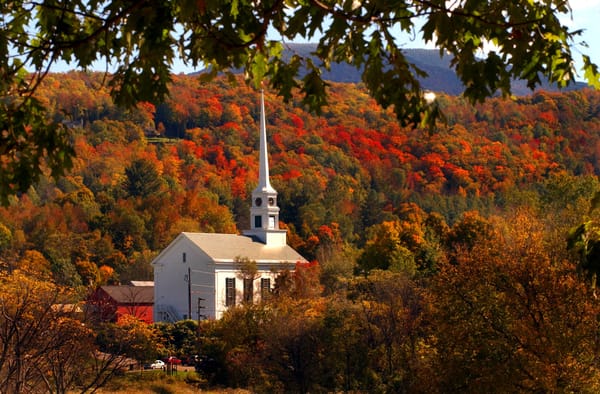There’s a genre of right-wing social media posting that’s dedicated to retro-Americana aesthetics: Norman Rockwell paintings, pictures of cute New England towns, preppy clothing, 1950s family scenes, Beach Boys-era Southern California, and similar things. The Trump administration has even gotten into the game, with the Department of Homeland Security posting a Thomas Kinkade paining of an idealized small-town scene.
But to the extent that any such aesthetics or lifestyles are actually practiced today, it’s usually by liberals, not conservatives.
Who is more likely to preserve or rehab historic buildings?”
Ask yourself: Who is more likely to be buying traditionally produced artisanal products? Who is more likely to prioritize “buying local” over patronizing the big box chain? Who is more likely to preserve or rehab historic buildings? Who wants to landscape with “native plantings”? Who actually lives in those cute New England towns? To ask these questions is to answer them.
Think about small town America. One would think that conservatives would be flocking to these places, rehabbing old Victorian homes, or opening a coffee shop or bookstore on the town’s Main Street. This does sometimes happen. But whenever we come across a high quality, intact, thriving small town, very often we discover that it’s a liberal enclave.
For example, The Financial Times recently highlighted the town of Stroudsburg, Pennsylvania, population 5,819, as an example of where progressive politics have flourished in a rural area. Stroudsburg, we are informed, is a picturesque, intact, well-governed, high-functioning town. It’s also a blue town in a red area.
The entire state of Vermont is an example of this writ large. Picturesque towns. Beautiful countryside. Billboards banned and big box stores heavily restricted. A constitutional carry state for firearms. A lively agricultural sector. Patriotic displays. High trust. A preserved embodiment of retro-Americana. It nominally would seem like a conservative paradise—and yet it’s very heavily Democrat.
Conservatives try to explain away these examples. Stroudsburg is a de facto college town, in the Poconos, and close enough to New York and Philadelphia to draw affluent, progressive urbanites. It’s the same arguments you hear for places like Hudson, NY.
But where are the conservative examples? How many similarly thriving small towns anywhere voted Republican in 2024? Perhaps some, but all too many of the actual red-voting small towns in America are struggling or clearly below the tier of the solidly liberal small towns like Woodstock, VT. And if you look at the New York Times precinct viewer map you’ll almost invariably see that even where the downtown and historic areas of small towns voted red, it’s a much lighter shade of red than the surrounding areas.
It isn’t a lack of money that’s stopping conservatives from creating or living in these places. Visit rural America and see plenty of people driving $80,000 super duties, or owning a $25,000 side by side or a high-end fishing boat. Or spend some time talking to them and learn that their family has season passes to Walt Disney World even though they live hundreds of miles from Florida. The Republican Party is becoming more working-class, but there are a lot of conservatives with money in rural America. They just have different spending priorities.
The actual conservative culture in much of America is not about the things imagined by the online “RETVRN” crowd. It doesn’t seem drawn to those things at all. It’s much more about a lifestyle oriented around consumption of products and activities that are thoroughly modern and industrialized. The people who want to preserve or recreate those retro elements are mostly on the left.
This helps explain some of the disconnect between the conservative elite and the Republican base. A lot of the conservative leadership class shares a significant part of the cultural outlook of progressives. They are culturally blue in an important way. That’s why much of the conservative intelligentsia lives in New York, Washington, or coastal California where they can live that lifestyle. They may have to be in these cultural centers to do their job, but they quite like it there. To be clear, I’m one of the people who shares that outlook.
Right wing influencers post those images because it’s what they like. But this isn’t actually what the Republican voting base is choosing.
It’s been said that movement conservatism never conserved anything. But what is it that actual conservative Americans want to conserve? It might not actually be what much of the online right imagines.
